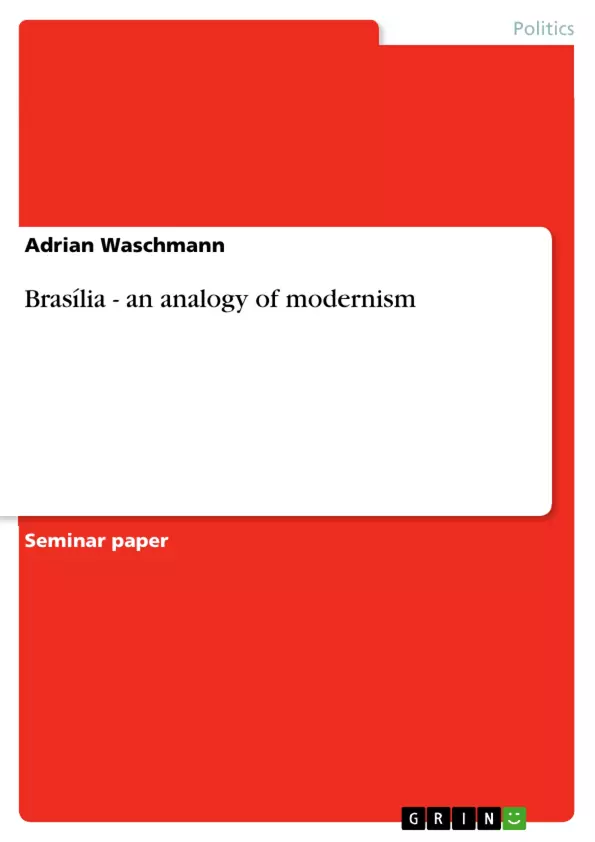Die Seminararbeit befasst sich mit der Entstehung der brasilianischen Haupstadt Brasília. Es wird die konzeptuele Phase beleuchten, ebenso wie die tatsächliche Erbauung der Stadt und der künstlerische und ideologische Rahmen in welchem das Bild der Stadt bedacht wurde. Hier werden vorallem die unterschiedlichen Ansätze beleutet mit dennen Kubitschek zum einem und Costa und Niemeyer zum anderen an das Project heran getreten sind. Abschließend wird ein Vergleich gezogen zwischen den Begriffen "Modernity" und "Modernism" und in den Konzept "Brasília" interpretiert.
Inhaltsverzeichnis (Table of Contents)
- 1. Introduction
- 2. The political vision – Juscelino Kubitschek
- 2.1 Introduction
- 2.2 Kubitschek's determination
- 2.3 “50 anos em 5”
- 3. The urban planning – Lucio Costa
- 3.1 Introduction
- 3.2 Le Corbusier
- 3.3 Athens in Brazil
- 3.4 “A Superquadra” – Costa's urban vision
- 4. Designing a capital – Oscar Niemeyer's aesthetics
- 4.1 Introduction
- 4.2 International Style
- 5. Modernism and Modernization
- 5.1 Brasília as epitome of a new Brazilian society
- 5.2 Plan and Reality
Zielsetzung und Themenschwerpunkte (Objectives and Key Themes)
This paper aims to analyze the construction of Brasília, the new capital of Brazil, inaugurated on April 23, 1960. It focuses on how a complete city was built from scratch in just seven years and explores the motivations, ideologies, and visions of the three main figures behind the project: Juscelino Kubitschek, Lucio Costa, and Oscar Niemeyer. The paper will examine the political and historical context, the planning process, and the architecture of Brasília, ultimately connecting the artistic term "modernism" with the sociological term "modernization" to understand Brasília's impact.
- The political and historical context surrounding the creation of Brasília
- The motivations and ideologies of the key figures involved in the project
- The urban planning process and the "Plano Piloto"
- The unique architecture of Brasília as a reflection of modernist principles
- The relationship between "modernism" and "modernization" in the context of Brasília
Zusammenfassung der Kapitel (Chapter Summaries)
Chapter 2 delves into the motivations behind Juscelino Kubitschek's decision to construct Brasília, emphasizing his determination to modernize Brazil and leave a lasting legacy. It explores his vision of a new capital that would symbolize a modern, progressive nation, as well as his ambitious "50 years of progress in five years of government" campaign.
Chapter 3 focuses on Lucio Costa's role in the urban planning of Brasília. It examines his influence from Le Corbusier's modernist ideas, particularly the concept of "Athens in Brazil," and analyzes his vision for "A Superquadra," a unique urban design element that would be central to Brasília.
Chapter 4 explores Oscar Niemeyer's contributions to the architecture of Brasília, highlighting his adherence to the International Style and its impact on the city's visual identity. This chapter delves into how his architectural designs embodied the modernist principles of clean lines, geometric forms, and a focus on functionality.
Schlüsselwörter (Keywords)
Brasília, modernism, modernization, urban planning, architecture, Juscelino Kubitschek, Lucio Costa, Oscar Niemeyer, "Plano Piloto", "50 anos em 5", International Style, Le Corbusier, "Athens in Brazil", "A Superquadra"
- Quote paper
- Adrian Waschmann (Author), 2012, Brasília - an analogy of modernism, Munich, GRIN Verlag, https://www.grin.com/document/203653



